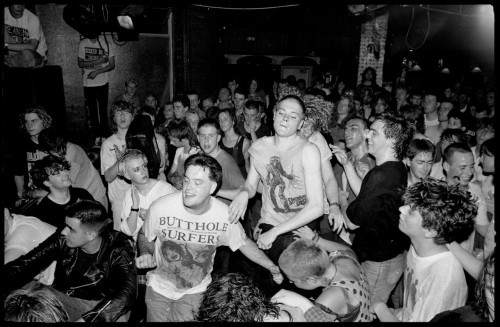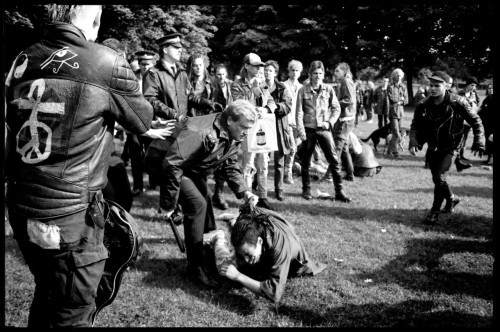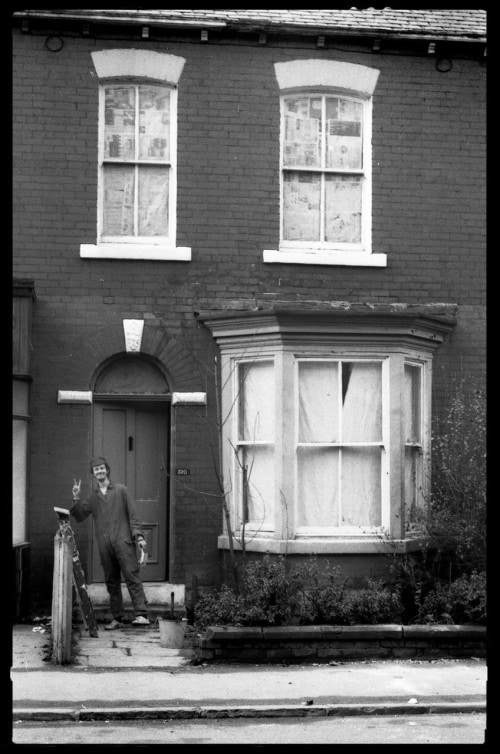Louis Tuckman visits the Andrew Bannerman-Bayles, My Generation photo exhibition at East Street Arts …
In the twenty years that the negatives for these photos have been lying about under the beds of Andrew Bannerman-Bayles and Andrew Medcalf’s rooms, a lot has changed in Leeds. Maybe that’s why now it seems relevant to bring them into discussion? These photos certainly raised a lot of interest from the people in them, who were presumably saying things like ‘look at your hair back then Dave, you twat’.
The photos are an accompaniment that goes along with ‘My Generation’, a West Yorkshire Playhouse production by Chumbawumba’s Alice Nutter. The play gave the images context. The photos and the performance work nicely together. The play tells a story of a family’s role in four major time periods of their politically active lives. I was surprised by how funny it was and how the story line gripped you as you became fond of the characters on stage.. I certainly wasn’t expecting a naked cartwheel at a rave scene.
Being in my twenties I probably have a different perspective to most that saw the play. Most people could probably remember what life was like during the miners’ strike or during nineties rave culture when the play is set. The way the people’s lives in the play change as their priorities evolve really struck some chords with me. It showed how history repeats itself but just adapts to the different environments.
It’s often hard to get much of a true impression from a photograph without knowing some of the story behind it. After watching the play and revisiting the photographs later they suddenly seemed to make sense. The scenes capture real life with so few impurities. Some of them seem so ordinary but that’s what makes them so believable. Where the fictional play presents the story that recreates what it was like to live in an alternative culture back then, the photographs give evidence that what happens in the play happened to real people that lived real lives.
But they also offer glimpses to the past, to inform younger people like me about what has changed since these photos were taken. I asked Adelle Stripe at East Street Arts what she thought was different back then and her reply was that people are simply cleaner now. The same DIY attitude happens, people still love putting on gigs, people still love things that are self organised. There just seems now to be a demand to look like you’ve washed.
Although, when I asked Andrew Bannerman-Bayles about this it was certainly reassuring when he said that back then people felt an equal need to keep up appearances. The grubby look was a result of genuine poverty to some but others made a real effort to look as ‘punk’ as possible which sometime meant looking a dirty as possible… just a fashion thing, the same as the clean look is today.
The big thing that has changed since then is that we now have the Internet. Everyone can find out about anything nowadays. I wonder if this would have stopped the squatters in the photos?
One of the things that Adelle said to me about the demonstrations and events that are portrayed in the photographs was that you were less likely to get battered by the police if you had a camera. It’s the same today. No one wants to get caught assaulting someone. That’s the power of the mechanical eye.
I was amazed by the story Andrew told me about this image above which depicts a scene of police brutality at a punk picnic. He said that he gave this photo to be used as evidence in court because the guy who’s being battered by the police had been arrested on accounts of assaulting the police. Obviously the photograph only offers a still but on Andrew’s website you can see the full story unfolding if you look out for the photos, which seem to be scattered in a random order.
I have to say I don’t know much about squatters. But talking to Andrew about the squats he used to live in definitely broke down the Daily Mail stereotypes of squatters. Just talking to a few of my friends about their views on squats reveals that most peoples fears are that they are going to break into your house and try to kick you out when you go to the shops. But that’s exactly the situation that people would inevitably avoid if they were looking for somewhere to live. When Squatters are looking for a building they will want to be as discreet as possible, because if they are seen then they will be evicted quicker and back on the streets.
When talking about things like this, Andrew drew particular attention to this photo above because this is a house that he’s lived in. The house had been empty for ages before they moved in. It was fucked. They replaced things like the floors themselves to make it liveable. The guy in the photo looks so happy because this was the day they’d lived in the house long enough that they felt they no longer needed to hide away, so they took the breezeblocks that were covering the windows. Presumably they still needed to have the curtains closed but this step forward towards having a home looks like it certainly made the guy in the photo happy.
The neighbours were very welcoming due to the fact the house was in danger of becoming derelict or burnt down by glue sniffers.
As there become more and more laws to stop squatting, people are turning to the idea of guardianship – where people pay a dramatically reduced amount of rent in return for looking after a house. It overcomes the same problems that squatting did. It gives people who would otherwise be on the streets somewhere to live when there are empty houses in the city, in danger of turning to ruin. But you can never become too attached as you could be evicted at any time.
The collection of photographs that Andrew’s collected during these years, un-cropped and un-edited, offers a true view of the times. As technology has advanced so much and now with everything so well documented, it makes you wonder what documentation of the present day will communicate when presented in twenty years time.
The play and the exhibition are still on until the 26th October so if you’re quick you may still catch them. If not, then you can view the photos online.


